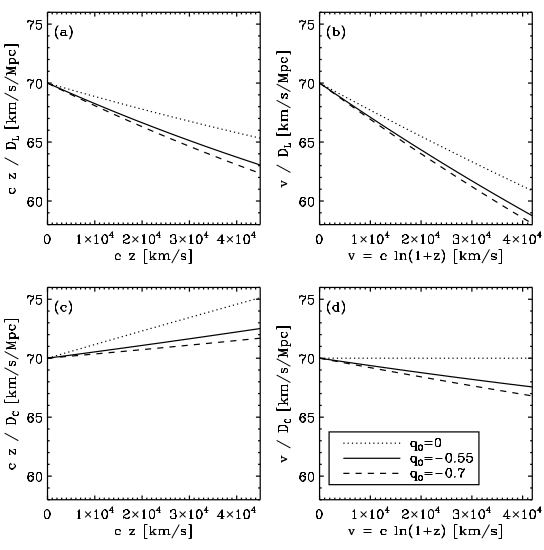A second-order Hubble Law
Ivan K. Baldry
Astrophysics Research Institute,
Liverpool John Moores University
IC2, Liverpool Science Park, 146 Brownlow Hill, Liverpool, L3 5RF, UK
Date: publication date 2021
The Hubble law is often stated such that the recession velocity is equal to the Hubble constant times the distance,
with the most common approximation for velocity given by  .
However, a more useful expression for velocity (e.g. Emsellem et al., 2019; Cappellari, 2017) is given by
.
However, a more useful expression for velocity (e.g. Emsellem et al., 2019; Cappellari, 2017) is given by
 |
(1) |
This is more accurate for pure line-of-sight velocity
and means that the peculiar velocity and cosmological terms,
and frame corrections, are additive (Baldry, 2018).
A common misconception is to assume  terms are additive.
Coupled with different distance definitions,
there are thus many versions of a Hubble law.
terms are additive.
Coupled with different distance definitions,
there are thus many versions of a Hubble law.
Figure 1:
Different views of the Hubble law.
The relations shown are for:
a coasting cosmological model ( ),
a flat
),
a flat
 model (
model ( ), and
a flat
), and
a flat
 model (
model ( ).
).
|
|
Figure 1 shows four different views of the
Hubble law using these approximations for velocity
with luminosity distance ( ) and line-of-sight comoving distance (
) and line-of-sight comoving distance ( ).
For each version, curves are shown for three model cosmologies,
all with flat geometry and with
).
For each version, curves are shown for three model cosmologies,
all with flat geometry and with  km s
km s Mpc
Mpc .
Two are
.
Two are  CDM models,
for which the deceleration parameter
CDM models,
for which the deceleration parameter
 ,
while the other is a `coasting' model with
,
while the other is a `coasting' model with  .
Notably, none of these versions of the Hubble law are accurate
except in the case of (d)
.
Notably, none of these versions of the Hubble law are accurate
except in the case of (d)
 for
the coasting model (Sutherland & Rothnie, 2015).
Note this exact law also is valid for a non-flat coasting model such as an empty universe
[though in this case,
for
the coasting model (Sutherland & Rothnie, 2015).
Note this exact law also is valid for a non-flat coasting model such as an empty universe
[though in this case,
 ].
Below we show a derivation of a second-order Hubble law that
is natural in this view with a transparent dependence on
].
Below we show a derivation of a second-order Hubble law that
is natural in this view with a transparent dependence on  .
.
For demonstration purposes, we consider a flat universe with a single type of fluid
with equation of state  such that:
such that:
 and and  . . |
(2) |
The comoving distance is then given by
 . . |
(3) |
Using the logarithmic shift
 , this becomes
, this becomes
 ; ; |
(4) |
and after integrating ( ),
),
![$\displaystyle D_{\rm C}\:=\: \frac{c}{H_0} \left[ \frac{1}{q} (1 - e^{-q \zeta} ) \right]$](img25.svg) . . |
(5) |
For a non-constant  , the above result is valid only over a small change in
, the above result is valid only over a small change in  .
For small
.
For small
 , using a second-order Taylor series expansion, we obtain
a second-order Hubble law:
, using a second-order Taylor series expansion, we obtain
a second-order Hubble law:
 . . |
(6) |
This form tends to the exact law with
 ,
and the right-hand term [
,
and the right-hand term [
 ] represents an average
of
] represents an average
of
 assuming constant acceleration
(c.f. the quadratic fitting function given by Sutherland & Rothnie (2015) for improved precision).
assuming constant acceleration
(c.f. the quadratic fitting function given by Sutherland & Rothnie (2015) for improved precision).
For  CDM cosmologies, the approximation is accurate to within 0.1% at
CDM cosmologies, the approximation is accurate to within 0.1% at
 .
Note that regardless of the accuracy of the Hubble law,
.
Note that regardless of the accuracy of the Hubble law,
 accurately represents the integral of the velocity differences along the line-of-sight,
precisely in the case of fundamental observers. This is evident from the additive nature of
terms in
accurately represents the integral of the velocity differences along the line-of-sight,
precisely in the case of fundamental observers. This is evident from the additive nature of
terms in  or
or  (Baldry, 2018).
(Baldry, 2018).
This article was published as an appendix of a paper on
`The effects of peculiar velocities in SN Ia environments on the local H0 measurement' by
Sedgwick, Collins, Baldry & James (2021).


 terms are additive.
Coupled with different distance definitions,
there are thus many versions of a Hubble law.
terms are additive.
Coupled with different distance definitions,
there are thus many versions of a Hubble law.













 and
and  .
. .
. , this becomes
, this becomes
 ;
; ),
),



 ,
and the right-hand term [
,
and the right-hand term [
 ] represents an average
of
] represents an average
of
 assuming constant acceleration
(c.f. the quadratic fitting function given by Sutherland & Rothnie (2015) for improved precision).
assuming constant acceleration
(c.f. the quadratic fitting function given by Sutherland & Rothnie (2015) for improved precision).




